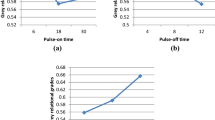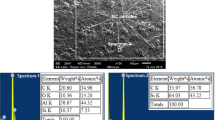Abstract
This paper presents an investigation on WEDM of pure titanium (grade-2). An attempt has been made to model the four response variables, i.e., machining rate, surface roughness, dimensional deviation and wire wear ratio in WEDM process using response surface methodology. The experimental plan is based on Box–Behnken design. The six parameters, i.e., pulse on time, pulse off time, peak current, spark gap voltage, wire feed and wire tension have been varied to investigate their effect on output responses. These responses have been optimized using multiresponse optimization through desirability. The ANOVA has been applied to identify the significance of developed model. The test results confirm the validity and adequacy of the developed RSM model. Finally, the optimum parametric setting has been designed for the optimization of process.
Similar content being viewed by others
References
Islam MN, Rafai NH, Subramanian SS (2010) An investigation into dimensional accuracy achievable in wire-cut electrical discharge machining. Proceedings of the World Congress on Engineering, vol III. London UK
Ezugwu EO, Wang ZM (1997) Titanium alloys and their machinability—a review. J Mater Process Technol 68:262–274
Lin YC, Yan BH, Chang YS (2000) Machining characteristics of titanium alloy (Ti–6Al–4V) using a combination process of EDM with USM. J Mater Process Technol 104:171–177
Sommer C, Sommer S (2005) Complete EDM handbook. Advance, Houston
Sarkar S, Mitra S, Bhattacharyya B (2006) Parametric optimization of wire electrical discharge machining of γ titanium aluminide alloy through an artificial neural network model. Int J Adv Manuf Technol 27:501–508. doi:10.1007/s00170-004-2203-7
Sarkar S, Mitra S, Bhattacharyya B (2005) Parametric analysis and optimization of wire electrical discharge machining of γ-titanium aluminide alloy. J Mater Process Technol 159:286–294. doi:10.1016/jmatprotech.2004.10.009
Hseigh SF, Chen SL, Lin MH (2009) The machining characteristics and shape recovery ability of Ti Ni X(X= Zr, Cr) ternary shape memory alloys using WEDM. Int J Mach Tools Manuf 49:509–514. doi:10.1016/jmachtools.2008.12.013
Hewidy MS, El-Taweel TA, El-Safty MF (2005) Modeling the machining parameters of wire electrical discharge machining of Inconel 601 using RSM. J Mater Process Technol 169:328–336. doi:10.1016/j.matprotech.2005.04.078
Mahapatra SS, Patnaik A (2006) Parametric optimization of wire electrical discharge machining (WEDM) process using Taguchi method. J Braz Soc Mech Sci Eng XXVIII(4):422–429
Kuang-Yuan K, Ko-Ta C (2008) Modeling and analysis of machinability evaluation in the wire electrical discharge machining (WEDM) process of aluminum oxide-based ceramic. Mater Manuf Process 23:241–250. doi:10.1080/10426910701860616
Porous D, Zaboruski S (2009) Semi empirical model of efficiency of wire electric discharge machining of hard to machine materials. J Mater Process Technol 209:1247–1253. doi:10.1016/j.jmatprotec.2008.03.046
Kuriakose S, Shunmugam MS (2005) Multi-objective optimization of wire-electro-discharge machining process by non-dominated sorting Genetic Algorithm. J Mater Process Technol 170:133–141. doi:10.1016/j.jmatprotec.2005.04.105
Liao YS, Yu YP (2004) Study of specific discharge energy in WEDM and its application. Int J Mach Tools Manuf 44:1373–1380. doi:10.1016/j.ijmachtools.2004.04.008
Spedding TA, Wang ZQ (1997) Study on modeling of wire EDM process. J Mater Process Technol 69:18–28. doi:10.1016/S0924-0136(96)00033-7
Scott D, Boyina S, Rajurkar KP (1991) Analysis and optimization of parameter combinations in wire electrical discharge machining. Int J Prod Res 29:2189–2207
Tarng YS, Ma SC, Chung LK (1995) Determination of optimal cutting parameters in wire electrical discharge machining. Int J Mach Tools Manuf 35:1693–1701
Liao YS, Huang JT, Su HC (1997) A study on the machining parameters optimization of wire electrical discharge machining. J Mater Process Technol 71:487–493
Manna A, Bhattacharya B (2006) Taguchi and gauss elimination method: a dual response approach for parametric optimization of CNC wire cut EDM of PRAISiCMMC. Int J Adv Manuf Technol 28:67–75. doi:10.1007/s00170-004-2331-0
Ramakrishnan R, Karunamoorthy L (2006) Multi response optimization of wire EDM operations using robust design of experiments. Int J Adv Manuf Technol 29:105–112. doi:10.1007/s00170-004-2496-6
Sarkar S, Sekh M, Mitra S, Bhattacharyya B (2008) Modeling and optimization of wire electrical discharge machining of γ-TiAl in trim cutting operation. J Mater Process Technol 205:376–387. doi:10.1016/j.jmatprotec.2007.11.194
Singh H, Khanna R (2011) Parametric optimization of cryogenic-treated D-3 for cutting rate in wire electrical discharge machining. J Eng Technol 1:59–64. doi:10.4103/0976-8580.86633
Yang RT, Tzeng CJ, Yang YK, Hsieh MH (2011) Optimization of wire electric discharge machining parameters for cutting tungsten. Int J Adv Manuf Technol. doi:10.1007/s00170-011-3576-z
Nihat T, Can C (2003) An investigation on wire wear in WEDM. J Mater Process Technol 134:273–278
Hewidy MS, El-Taweel TA, El-Saft MF (2005) Modeling the machining parameters of wire electrical discharge machining of Inconel 601 using RSM. J Mater Process Technol 169:328–336
Scott MF, Kao C-C, Albert SJ, Jun Q (2005) Investigation of wire electric discharge machining of thin cross-sections and complaint mechanisms. Int J Mach Tools Manuf 45:1717–1725
Anish K, Vinod K, Jatinder K (2012) An Investigation into machining characteristics of commercially pure titanium (Grade-2) using CNC WEDM. Appl Mech Mater 159:56–68. doi:10.4028/www.scientific.net/AMM.159.56
Probir S, Abhijit S, Surjya PK (2008) Soft computing models based prediction of cutting speed and surface roughness in wire electro-discharge machining of tungsten carbide cobalt composite. Int J Adv Manuf Technol 39:74–84. doi:10.1007/s00170-007-1200-z
Biing YH, Hsien TC, Fuang HY, Long LC (2005) Examination of wire electric discharge machining of Al2O3p/6061Al composites. Int J Mach Tools Manuf 45:251–259
Ranganath BJ, Prakash CPS (2005) Wire failure analysis in the WEDM process. Manuf Technol Toda 19–24
Ramakrishnan R, Karunamoorthy L (2004) Surface roughness model for CNC wire electro discharge machining. Manuf Technol Toda 8–11
Sarkar S, Sekh M, Mitra S, Bhattacharyya B (2011) A novel method of determination of wire lag for enhanced profile accuracy in WEDM. Precis Eng 35:339–347. doi:10.1016/j.precisioneng.2011.01.001
Derringer G, Suich R (1980) Simultaneous optimization of several response variables. J Qual Technol 12:214–219
Montgomery DC (1997) Design and analysis of experiments, 4th edn. Wiley, New York
Author information
Authors and Affiliations
Corresponding author
Rights and permissions
About this article
Cite this article
Kumar, A., Kumar, V. & Kumar, J. Multi-response optimization of process parameters based on response surface methodology for pure titanium using WEDM process. Int J Adv Manuf Technol 68, 2645–2668 (2013). https://doi.org/10.1007/s00170-013-4861-9
Received:
Accepted:
Published:
Issue Date:
DOI: https://doi.org/10.1007/s00170-013-4861-9




